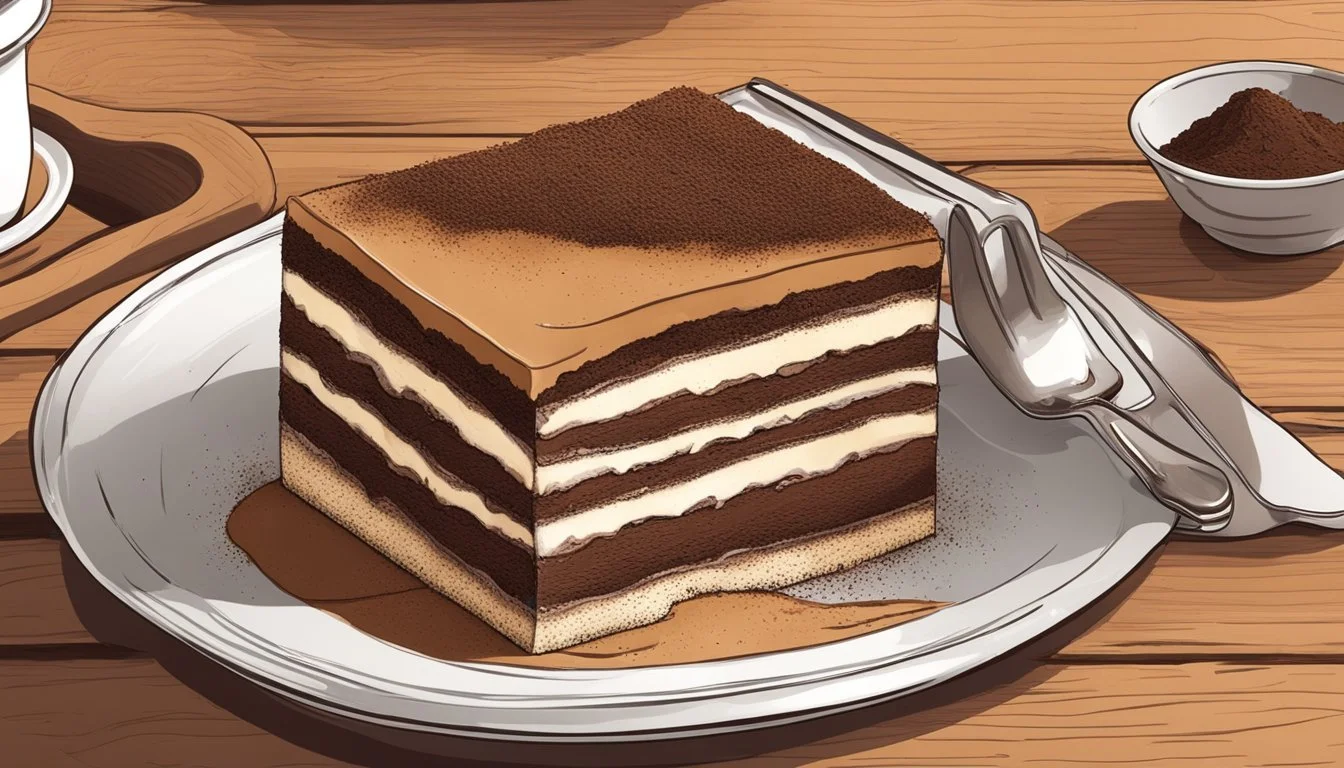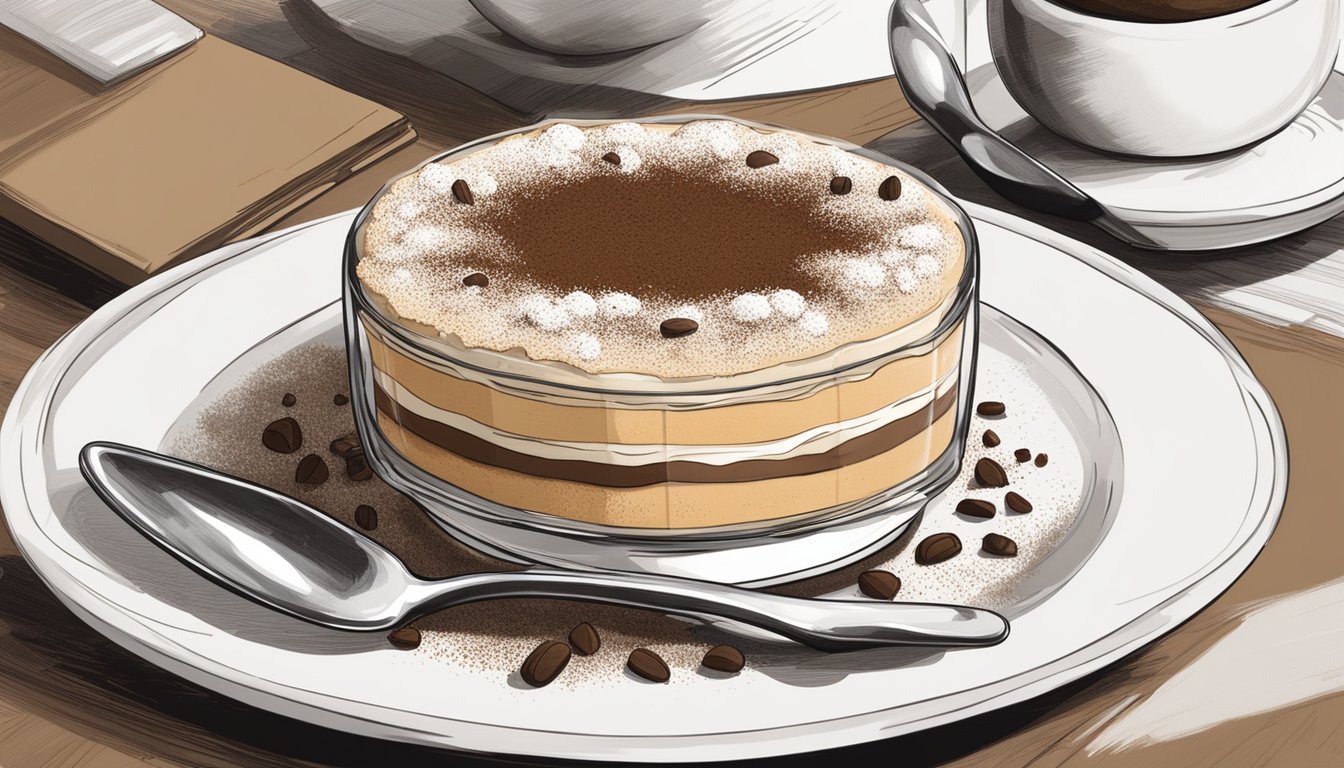How Long Does Freshly Prepared Tiramisu Last?
Shelf Life and Storage Tips
Tiramisu, a beloved Italian dessert featuring layers of coffee-soaked ladyfingers and a rich, creamy mixture of eggs, sugar, and mascarpone cheese, topped with a dusting of cocoa, is as delightful to taste as it is delicate to preserve. Keen on satisfying texture and full flavors, aficionados and casual fans alike often ponder the longevity of this indulgent treat when freshly prepared and stored in a home refrigerator.
Following preparation, the clock starts ticking for enjoying tiramisu at its peak quality. The dessert typically remains in good condition for up to four days when refrigerated. It is essential to store tiramisu in an airtight container to maintain its moisture levels without becoming soggy, as the interplay between the custard and the moisture from coffee-infused ladyfingers is crucial. Proper storage in a refrigerator not only helps in preserving its nuanced flavors but also keeps the dessert safe for consumption.
Understanding that the components of tiramisu can react to storage conditions, safety becomes a priority alongside taste. The presence of raw eggs in the custard base, often a concern for food safety, typically remains safe to eat within this four-day timeframe, given the refrigeration slows down bacterial growth. To extend the joy that tiramisu brings beyond the usual refrigerated shelf life, freezing the dessert is a viable option, allowing it to be kept for up to three months without a significant compromise on its texture or taste when properly wrapped and sealed.
Fundamentals of Tiramisu Preservation
Proper preservation techniques are crucial for extending the shelf life of tiramisu while maintaining its quality. From the selection of ingredients to the method of storage, each step plays a pivotal role.
The Role of Ingredients
Tiramisu's longevity starts with the quality of its components. Using pasteurized eggs is essential as they reduce the risk of food poisoning from bacteria like salmonella. The mascarpone cheese should be fresh and of high quality, as dairy products are prone to spoilage. Ingredients like alcohol can act as a preservative to extend the shelf life of tiramisu, provided it is integrated in the right amount.
Ingredients Affecting Shelf Life:
Pasteurized eggs: Safer for consumption; lower bacteria risk
Fresh dairy products: Vital for taste and safety; check expiry dates
Quality of ladyfingers: Stale ladyfingers can compromise structure and taste
Alcohol content: Can serve as a preservative
Refrigeration Essentials
After preparation, tiramisu must be stored in the refrigerator to keep it from spoiling. The optimal storing temperature is 40°F (4°C) or below to keep bacteria and mold growth at bay. Tiramisu should be placed in an airtight container to prevent it from absorbing other flavors and odors from the refrigerator and to maintain its moisture levels.
Key Refrigeration Tips:
Cool tiramisu before storing: Prevents condensation and sogginess
Use an airtight container: Keeps out odors and retains freshness
Maintain consistent temperature: Ensures safety and quality preservation
Freezing Techniques
For long-term storage, tiramisu can be frozen, extending its shelf life up to three months. When freezing, first allow the dessert to chill thoroughly in the fridge. Then, wrap the tiramisu tightly with plastic wrap followed by aluminum foil to prevent freezer burn and taste alterations. To consume, thaw the tiramisu in the refrigerator for several hours, maintaining the integrity of the cream and ladyfinger cookies without fostering bacteria growth.
Steps for Freezing Tiramisu:
Chill: Firm up the cream and structure
Wrap: Use layers for tight sealing—plastic wrap, then aluminum foil
Freeze: Set temperature to 0°F (-18°C)
Thaw: In the refrigerator for controlled defrosting
By observing these fundamentals of tiramisu preservation, its delicate balance of flavors and textures can be enjoyed safely for an extended period.
Optimal Storage Conditions
Proper storage is crucial for extending the shelf life of freshly prepared tiramisu. It hinges on maintaining an airtight environment, controlling temperature, and minimizing contamination.
Airtight Protection
An airtight container is essential to prevent exposure to air, which can lead to oxidation and spoilage of tiramisu. Wrapping the dessert individually with plastic wrap or aluminum foil before placing it in the container can provide an extra barrier against odors and keeps the dessert moist.
Temperature Regulation
The ideal temperature for storing tiramisu is within the refrigerator at around 34°F to 40°F (1°C to 4°C). This temperature range slows down bacterial growth and deters mold development, directly impacting the dessert's shelf life.
Avoiding Contamination
To avoid contamination, one should use clean utensils when serving tiramisu and store it away from foods with strong smells or odors. Ensuring the tiramisu remains sealed protects it from absorbing other flavors and guards against bacterial infiltration.
Assessing Tiramisu Quality
The quality of tiramisu can be determined through a series of sensory evaluations that include visual, olfactory, and textural indicators. These assessments help ensure that the dessert maintains the high standards expected of this classic, coffee-flavored treat.
Visual Indicators
One can judge the quality of tiramisu by its color and presentation. Fresh tiramisu should display even layers with no signs of separation. The color should be a harmonious blend of cream and the slight darkness of the coffee-soaked ladyfingers. Any discoloration, such as a darker hue or yellowing of the cream, may indicate age or poor storage conditions.
Even and consistent coloring: Suggests freshness.
Discoloration or separation: May indicate the dessert has gone bad.
Olfactory Cues
Smell is a powerful tool for assessing the quality of tiramisu. The dessert should emit a pleasant coffee aroma with subtle hints of cocoa from the dusting on top. A fresh tiramisu will not have any sour or off-putting odors. The presence of a sour smell may indicate bacterial growth, and the tiramisu should not be consumed.
Pleasing coffee and cocoa scent: Indicates good quality.
Sour or unpleasant odors: A sign that the tiramisu has gone bad.
Textural Clues
The texture of tiramisu should be creamy and smooth, with ladyfingers that are tender but still firm enough to provide structure. An optimal texture is crucial for a proper tiramisu experience. If the cream appears watery or the ladyfingers are soggy to the point of disintegrating, the dessert may have gone bad or was not made properly to begin with.
Creamy, with tender yet firm ladyfingers: Indicates a freshly prepared tiramisu.
Watery cream or overly soggy ladyfingers: May suggest the tiramisu is bad.
Shelf Life and Consumption Safety
Understanding the shelf life and safe consumption practices for tiramisu ensures both optimal taste and health safety. The lifespan of tiramisu varies based on storage conditions and preparation methods.
Refrigerated Tiramisu
Refrigerated tiramisu remains safe to eat for up to three to four days when stored in an airtight container. It's crucial to maintain a consistent refrigerator temperature of 40°F (4°C) or below to minimize the risk of bacterial growth. Fresh ingredients and proper hygienic practices during preparation can extend this shelf life, but for optimal taste, consumption within this time frame is recommended.
Frozen Tiramisu
When tiramisu is frozen, its consumption safety extends significantly. Properly wrapped tiramisu can last for up to three months in the freezer. To freeze, one should first let the dessert firm up in the refrigerator and then wrap it tightly in plastic wrap. Though safe to eat beyond this period, the quality—especially texture and flavor—may degrade.
The Impact of Preparation Methods
Homemade tiramisu, using fresh ingredients and following meticulous preparation steps, offers a short yet quality shelf life. Conversely, store-bought tiramisu should be consumed quickly, often within hours of purchase, and it is essential to adhere to the expiration date on the label. The specific combination of ingredients—like mascarpone, eggs, and alcohol—influences not only the flavor but also the shelf life. For special occasions, when tiramisu is served as the dessert of choice, one must consider these factors to ensure the Italian dessert is both delightful and safe for guests.
Preparation Tips for Longevity
To ensure tiramisu retains its delightful taste and texture for an extended period, one must pay attention to the selection of ingredients and the assembly process. Proper storage techniques are also crucial to maintain the dessert's freshness.
Choosing Quality Ingredients
High-quality ingredients are the cornerstone of a tiramisu that not only tastes rich and creamy but also lasts longer. One should opt for fresh mascarpone cheese, as it contributes to the creamy texture while preventing the dish from turning sour quickly. Fresh, grade A eggs are essential for a safe and stable zabaglione, the custard base that combines with the mascarpone. Savoiardi biscuits, or ladyfingers, should be crisp as they provide the needed structure to the dish. For the coffee mixture, freshly brewed espresso or strong coffee ensures a robust flavor that complements the creamy layers.
Proper Layering Technique
Correctly layering tiramisu plays a role in its longevity. The foundation involves a layer of savoiardi biscuits briefly soaked in the egg-based coffee mixture. They should be damp but not overly saturated, to prevent a soggy texture. This is followed by a layer of the zabaglione and mascarpone mixture:
First Layer: Savoiardi biscuits dipped in coffee
Second Layer: Zabaglione and mascarpone cheese blend
It's essential to alternate these layers until the container is nearly full, finishing with a layer of the creamy mixture. Finally, a dusting of unsweetened cocoa powder or grated dark chocolate seals the flavors and adds an antioxidant component that may help preserve the quality.
Sealing for Freshness
Once assembled, sealing the tiramisu is imperative to extend its shelf life. The dessert should be placed in an airtight container to limit exposure to air and moisture, which can lead to spoilage. If a container is not available, wrapping the dish tightly with plastic wrap can suffice. It's recommended to store the tiramisu in the refrigerator to maintain a cool environment that slows down bacterial growth, thus preserving its freshness for up to three days. For longer storage, freezing is an option, and when done properly in a sealed container, can extend the tiramisu's life for up to three months.
Thawing and Reheating Guidelines
When dealing with frozen tiramisu, the thawing process is crucial to maintain the dessert's integrity, and understanding how its texture and taste can be affected post-thaw is key to enjoying this delicacy.
Defrost Process
Frozen tiramisu should be moved from the freezer to the refrigerator for a slow thaw, typically taking 24 hours. This gradual change in temperature helps prevent the formation of excessive moisture which can lead to a soggy texture. It is important to keep the tiramisu in its original airtight container or in a tray wrapped in plastic to protect it from absorbing other flavors and odors from the refrigerator.
Post-Thaw Texture and Taste
The texture of thawed tiramisu may not precisely match that of a freshly prepared one, but if properly stored and then thawed, it should still maintain a creamy consistency. The taste remains largely intact, especially if the tiramisu has only been frozen for a short period. Leftovers tend to retain their delicious flavor profile, although one may notice subtle differences if kept frozen beyond a month, as the quality starts to decline gradually. It's best served soon after thawing to ensure the dessert is enjoyed at its optimum state.
Tiramisu Presentation Tips
When presenting Tiramisu, one should focus on the dessert’s texture and layering, ensuring the sponge cake or ladyfingers maintain their soft yet firm structure and that the toppings enhance both the flavor and aesthetic appeal.
Serving Suggestions
When serving Tiramisu, a clean and efficient presentation is key. One should:
Begin by chilling the Tiramisu in the refrigerator prior to serving. This step allows the cream to firm up and stabilizes the layers for a neater presentation.
Use a sharp knife to cut through the dessert, ensuring that both the soft mascarpone layer and the sponge cake or ladyfingers retain their distinct layers.
Employ a pie server or spatula to carefully lift each piece from the serving dish to the plate. This tool should slide easily under the Tiramisu, providing full support to the structure.
Decoration and Toppings
Tiramisu’s classic look is simple yet elegant, featuring a dusting of cocoa or grated dark chocolate on top. To perfect this finishing touch, one should:
Sift cocoa powder through a fine mesh strainer for an even, light dusting that provides a stark contrast to the creamy hues below.
Alternatively, sprinkle a layer of grated dark chocolate over the dessert for a richer chocolate flavor and a more textured appearance.
If cling film is used during the refrigeration process, ensure it does not touch the surface of the Tiramisu. This can cause the toppings to stick to the film and ruin the silk-smooth finish.
By adhering to these tips, the Tiramisu will not only taste delightful but also look impeccably served.
Understanding Tiramisu Ingredients
The longevity of tiramisu largely depends on its components, which mainly include dairy products, eggs, alcohol, and espresso. These ingredients impact not only the flavor and texture but also how well the dessert preserves over time.
Eggs and Dairy
Tiramisu typically includes raw eggs and mascarpone cheese, a type of dairy. Eggs are separated, with the yolks often beaten with sugar and combined with mascarpone to create the rich, creamy layer of the dessert. The dairy component, particularly mascarpone, provides a thick and indulgent consistency, yet these ingredients are perishable and necessitate prompt and proper refrigeration.
Egg Yolks: Susceptible to bacterial growth if not handled or stored correctly.
Mascarpone: A velvety cheese that should be kept cold.
Shelf Life Considerations:
Egg yolks can raise food safety concerns; use pasteurized eggs to increase shelf life.
Mascarpone, being a fresh cheese, can spoil quickly and should always be kept refrigerated.
Alcohol and Espresso
The layers of tiramisu are infused with a rich coffee flavor, frequently achieved by soaking ladyfingers in espresso. The addition of alcohol such as brandy, rum, or other liquors, imparts depth to the tiramisu and acts as a flavor enhancer.
Espresso: Integral for the characteristic coffee flavor of tiramisu.
Alcohol: Often included for taste; can be rum or brandy.
Preservative Effects:
Alcohol: Can act as a minor preservative, potentially extending the dessert's shelf life slightly.
Espresso: Generally does not contribute to preservation but is crucial for the tiramisu's signature taste.
It is essential for consumers to be aware that while alcohol may slightly extend the tiramisu's lifespan, it does not negate the need for proper storage because of the perishable dairy and egg components.
Tiramisu Myths Debunked
Myth 1: Tiramisu Lasts for Weeks A common misconception is that tiramisu can last for weeks in the refrigerator. In truth, for optimal freshness and flavor, tiramisu should be consumed within 2 to 3 days of preparation.
Shelf Life Reality In the Fridge 2-3 days, after which the quality begins to decline. Frozen Freezing can extend its life, but expect texture changes after a month.
Myth 2: Freezing Doesn’t Affect Quality Freezing tiramisu does extend its shelf life, but it's not a magical solution that preserves the dessert indefinitely. Fine changes in texture and flavor occur, and while it's safe to consume, the quality is best within the first week of freezing.
Myth 3: Air Exposure is Harmless Contrary to some beliefs, tiramisu needs to be tightly covered when stored. Exposure to air can cause it to dry out and affect both taste and texture. Always store it in an airtight container.
Myth 4: Soggy Ladyfingers Are Normal Soggy ladyfingers are often considered a typical characteristic of tiramisu. However, they should be dipped quickly — merely the in-and-out technique — to maintain structure. Overly soaked ladyfingers compromise the dessert's integrity.
By addressing these myths, they help to ensure that tiramisu is always enjoyed as intended, preserving its delicate balance of flavors and textures.
Advanced Tiramisu Variations
When one ventures beyond the classic Italian dessert, Tiramisu can be adapted to various sophisticated flavor combinations and dietary requirements. These variations maintain the essence of the dessert while catering to different palates and nutrition preferences.
Flavor Combinations
Traditional Tiramisu involves layers of coffee-soaked ladyfingers and a rich mascarpone cream. Advanced variations, however, explore a range of flavors that can complement or contrast with the coffee base.
Fruit-infused: Incorporation of citrus zest or layered fresh berries can add a tart contrast to the sweet, creamy elements.
Liqueur-flavored: While Marsala wine is traditional, chefs might infuse the dessert with other liqueurs such as Amaretto for an almond twist, or Frangelico for a hazelnut profile.
Chocolate-intensified: For chocolate lovers, additional layers of fine dark chocolate ganache or a chocolate-hazelnut spread can be interwoven with the classic components.
Dietary Adjustments
Catering to varying dietary needs doesn't mean one must forsake Tiramisu on special occasions; rather, it calls for creative substitutions.
Gluten-Free: Gluten-free ladyfingers are readily available or can be homemade to accommodate those with gluten sensitivities.
Lactose-Free: Mascarpone can be substituted with lactose-free cream cheeses or coconut cream for a dairy-free version.
Vegan: Egg replacements such as aquafaba and vegan cream cheese alternatives can be used to create a dessert that aligns with vegan dietary restrictions.











